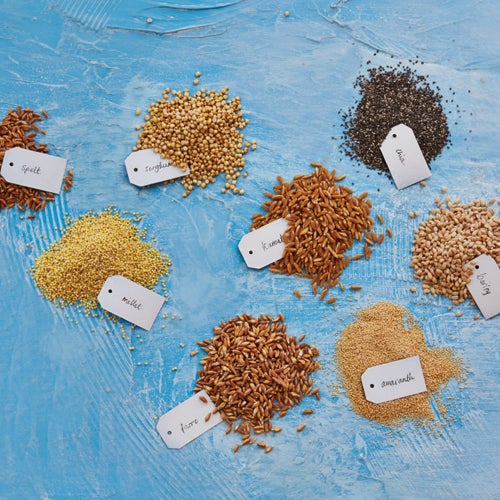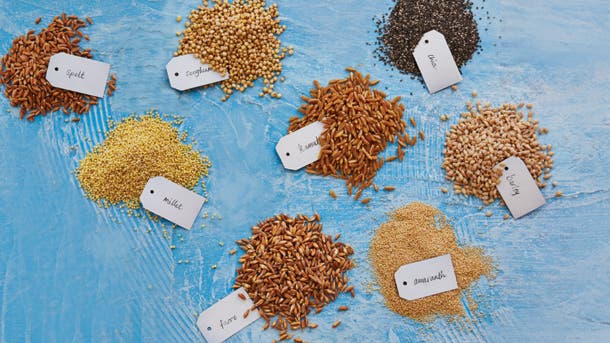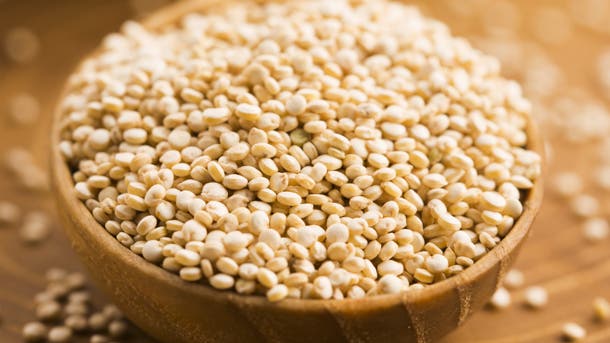Guide to Ancient Grains


If sorghum, millet, quinoa, amaranth and bulgur haven’t made their way to your plate yet, it’s only a matter of time.
According to the research firm DataEssential, these ancient grains saw more growth on restaurant menus than any other grain in 2015, and the National Restaurant Association has included ancient grains on its annual Top-20 list of culinary trends since 2014.
But what makes grains “ancient,” and are they really all that better than common grains?
According to the Whole Grains Council, ancient grains have been mostly unchanged by selective breeding over the past several hundred years. Unlike modern varieties of corn, rice and wheat that have been modified by farming techniques and science, ancient grains such as spelt, einkorn, quinoa, millet and farro have been largely untouched. Ideally this means they should look and taste much like they did centuries ago and should have retained their original nutritional properties.
Whether they’re any healthier for us than modern grains is still up for debate, however. Like any whole grain, ancient grains are unrefined, so they haven’t been stripped of valuable nutrients during the milling process. Whole grains’ fiber content in particular has been shown to help lower cholesterol, prevent blood clots from forming and regulate blood sugar (an important factor in preventing Type 2 diabetes).
Ancient grain advocates also tout them for being higher in protein, omega-3 fatty acids, antioxidants and several vitamins and minerals than modern grains. Some ancient grains are gluten-free (amaranth, quinoa, buckwheat, millet, teff), while the ancient wheat varieties (spelt, einkorn, kamut, freekeh) are not, though there’s evidence that even these are more easily digested for the gluten-sensitive.
Here’s a bit more about 12 ancient grains sprouting up on menus today!
Learn more about why healthy whole grains are a part of the clean eating lifestyle.

1. Amaranth
Amaranth is known as a “pseudo cereal,” meaning that it doesn’t belong to the same species of plants (Poaceae) that oats, wheat and other common grains do, but it still contains many of the same nutrients and is consumed in similar ways as these other cereal grains.
A staple of the Aztecs, the golden-hued amaranth is now an essential ingredient in many cultures’ cuisines, including in several South American countries, where it’s popped like corn, and in India, where it’s served up for breakfast porridge-style. It cooks up much like rice, and while it gets soft on the inside, it remains somewhat firm on the outside, giving it a “pop”-like effect in your mouth when chewed.
Amaranth contains roughly 14% protein, making it one of the most protein-rich grains available.
See also Pumpkin Amaranth Bowl recipe

2. Barley
Barley is the most widely consumed cereal crop after wheat, rice and corn. Soft and chewy when cooked up, it’s most often used as a hearty addition to soups and salads, on its own as a savory side, or milled into flour to bake bread.
Because of its rich fiber content (up to 30% compared with 12% for wheat and 3.5% for brown rice), barley has been hailed for its ability to reduce blood pressure, lower LDL “bad” cholesterol, regulate blood sugar and control weight gain by curbing the appetite.
Fun fact: Christopher Columbus reportedly brought barley to North America on his second voyage in 1494, but the crop didn’t gain popularity in America for another 200-plus years, when English settlers recognized its potential for brewing beer.
See also Barley & Apple Stuffed Acorn Squash.

3. Buckwheat
If you love soba noodles, galettes or blintzes, you’re likely already a fan of buckwheat, which tends to be the main ingredient of these delectable dishes.
Much like its amaranth cousin, buckwheat is a “pseudo-cereal” that produces groats (or kernels) shaped like small triangles with rounded edges. While it first popped up in what’s now Eastern Europe circa 4000 BC, it’s incredibly popular today in Central and Southeast Asia, as well as in the Middle East and parts of Europe.
Buckwheat boasts several potential health benefits, thanks to its high levels of protein, potassium, zinc, copper and manganese. It’s also high in soluble fiber, which can regulate blood sugar, and some of its flavonoid compounds (naturally occurring chemicals found within plants) have been shown to help control blood pressure and protect against some types of cancer.
See also Mini Blueberry Buckwheat Ricotta Dessert Pancakes

4. Bulgur
Boil, dry, crack and sort almost any kind of wheat and you’ll end up with bulgur. Similar to pasta, bulgur is extremely versatile and can be boiled up quickly to use in salads, soups or side dishes, including the popular Mediterranean dish tabbouleh. Bulgur is chock full of fiber – even more so than quinoa, oats, millet or buckwheat – and registers low on the glycemic index, so it’s great for controlling blood sugar levels. Since it’s a wheat product, however, it is not gluten free.
See also Bulgur Eggplant Parmesan

5. Farro (also called Emmer)
While referred to as one grain, farro actually comprises three grains: einkorn, emmer and spelt. This family of grains are considered “covered” wheats, meaning the kernels still need to be removed or “hulled” after harvesting.
Originating from Egypt, farro is popular today in Italy, where it’s favored as a pasta substitute, and in Ethiopia, where it makes up roughly 7% of wheat grown.
Farro’s nutty, chewy kernels are a bit plumper than barley and can be used in any dish that calls for rice or quinoa – soups, salads, sides, stir-frys, etc. For the freshest farro, buy it as a whole grain and crack it yourself in a coffee grinder.
Since farro is another wheat variety, it does contain gluten, but it’s also high in protein, fiber, various minerals, such as zinc, magnesium, iron and niacin, which helps your body digest carbs, fat and protein.
See also Roasted Salmon & Summer Vegetable Farro Salad

6. Freekah
Popular in Middle Eastern countries, freekeh (also called “farīk”) is made from a young, green durum wheat. Once harvested it goes through a roasting, rubbing and cracking process that lends to its distinct nutty, smoky flavor and soft, chewy texture.
Freekeh is rich in protein (four times the amount of brown rice), calcium, protein, lutein (good for your eyes) and prebiotic properties (great for your gut). It also racks up fewer calories per serving than quinoa, brown rice or farro, making it a diet-friendly option for pilafs, savory sides or as a breakfast porridge.

7. Kamut (Khorasan Wheat)
Kamut is the brand name for the ancient khorasan wheat grain, which may have originated in Mesopotamia and has links to ancient Egypt. Today it’s grown primarily on certified organic farms in Montana, Alberta, and Saskatchewan and comes with a guarantee of never being genetically modified or hybridized.
Three times the size of modern wheat, the sweet, nutty Kamut boasts more protein, amino acids, vitamins and minerals (notably selenium, zinc, potassium, iron, phosphorus and magnesium) than modern wheat. A recent study also found that kamut can help reduce LDL “bad” cholesterol and blood glucose, making it a nutritious substitute for modern wheat. While it might be more digestible than modern wheat products, it does contain gluten. Substitute kamut for wheat in any of your favorite dishes, from pancakes to pilafs.
See also Biryani-Style Chicken Kamut

8. Millet
Millet is the name for a family of small related grains. You might recognize it as a common ingredient in bags of birdseed, but this ancient grain has been a staple of cuisines the world over for centuries, including in India (where it’s milled into flour and baked into the savory flatbread roti), China, South America, Russia and several African countries (where it’s cooked up as a porridge and brewed into beer).
Millet is gluten-free and extremely versatile, making it the perfect substitute for wheat, corn and rice in both savory and sweet dishes. It’s also naturally high in protein, antioxidants and minerals, especially magnesium, which promotes muscle and nerve health.
See also Peach and Millet Pancakes

9. Quinoa
A favorite of gluten-free gurus, quinoa has been grown for centuries in the Andes of South America, where the Incas dubbed it their “Mother Grain.” It’s not a grain at all, in fact, but a seed that’s botanically closer to swiss chard and beets. It’s often lumped in with other grains, however, since it cooks up similarly and retains many of the same nutrients.
Quinoa seeds are small, round and typically tan in color but also come in red, black and purple. Rinsing quinoa before cooking helps to remove the seeds’ bitter-tasting hulls, leaving a mild, nutty flavor that lends itself well to soups, salads, rice-like sides and stir-frys.
Quinoa also makes for a protein-packed filler in veggie burgers and burritos. In fact, quinoa is one of the only plant-based “complete” proteins, offering all the essential amino acids that our bodies can’t make on their own.
See also Loaded Quinoa Bowl

10. Sorghum
Traditionally used in the U.S. to feed livestock and produce ethanol, sorghum is treasured by farmers for being able to sustain most conditions and need a third less water to thrive than other ethanol-producing plants.
Roughly 50% of the world’s sorghum is still used for food, however, notably in Africa, where the grain originated and where it’s still cooked up like popcorn, turned into porridge, brewed as beer, made into couscous and milled into flour for bread. It’s also a staple grain in parts of India, Mexico and Central America, and is finally growing in popularity in America as yet another gluten-free alternative to wheat.
Aside from being celiac-friendly, sorghum is a great source of protein (combine with pulses such as chickpeas to create a complete protein!), iron and B vitamins.
See also Curry Carrot Salad with Sorghum

11. Spelt
Another “covered” wheat variety, spelt was originally grown throughout Europe and southwestern Asian countries, but it eventually was replaced with modern wheat that was more easily hulled and processed. Today spelt is grown primarily in Europe, Canada and the U.S., where it’s gaining in popularity as an alternative to modern wheat in baked goods, pastas, tortillas, cereals and desserts. While it still contains gluten, spelt boasts more protein, riboflavin, potassium and niacin than most modern wheat varieties.
See also 3-Ingredient Spelt Pizza Crust

12. Teff
Teff kernels are so small (slightly smaller than quinoa kernels) they’re named for the Amharic word “teffa,” which means “lost.” This type of millet grain has long been a staple in Ethiopia, where it’s milled into flour and turned into the popular pancake-like bread called injera. The gluten-free grain is gaining in popularity in America, however, turning up in recipes for gluten-free baked goods, waffles, pancakes and breads. It also makes for a hearty addition to soups and stews, and its slightly sweet, nutty flavor makes it perfect as a warm, creamy breakfast porridge, similar to cream of wheat. Teff boasts 20 percent of your daily iron (more than twice that of other grains) and has triple the amount of calcium as other grains.
See also Fall Vegetable Bowl with Teff Dukkah